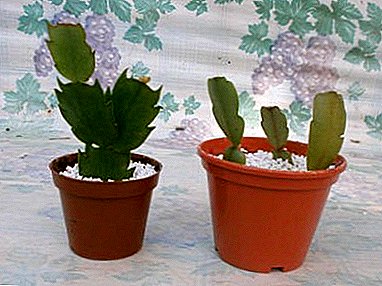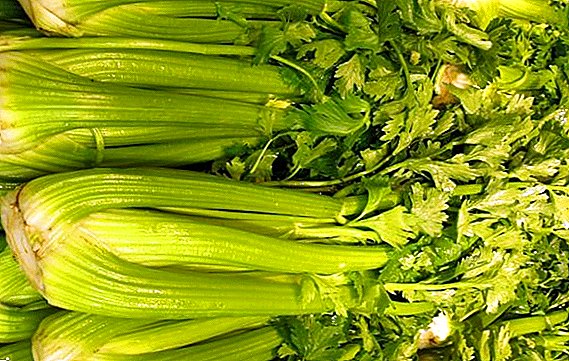 Fragrant leaves, seeds and celery roots are used in national cuisines of many countries, giving the dishes an exquisite taste and smell. This article discusses how to prepare celery for future use by drying and freezing.
Fragrant leaves, seeds and celery roots are used in national cuisines of many countries, giving the dishes an exquisite taste and smell. This article discusses how to prepare celery for future use by drying and freezing.
When and how to harvest?
Leaf celery is harvested 5-8 months after sowing seeds into the ground or 3-6 months after transplanting seedlings to a permanent place. Terms of collection depend on the variety, season and cultivation conditions of the crop. Harvesting of greens begins when the stalks develop well, become thick and fleshy, and the greens are lush. Green celery is harvested by hand. The above-ground parts of the plant are cut with a sharp knife or special pruner, just below the point where the leaves grow. At the same time old, rough, damaged leaves are thrown away.
Celery roots are dug up when they grow to the size of a large apple. On large fields, root crops are dug with the help of special equipment; in small household plots, plant growers harvest crops from the ground with garden forks with blunt ends or a bayonet spade. Dug out the roots cleaned from the earth and dried in partial shade in a few days.  Dry root vegetables are placed in plastic, cardboard or wooden boxes, covered with sand between gaps and placed in a dry, well-ventilated basement for long-term storage. It is also possible to carry out preparations for storage in this way: washed and dried roots are dipped in a clay talker, and then dried vegetables in the sun.
Dry root vegetables are placed in plastic, cardboard or wooden boxes, covered with sand between gaps and placed in a dry, well-ventilated basement for long-term storage. It is also possible to carry out preparations for storage in this way: washed and dried roots are dipped in a clay talker, and then dried vegetables in the sun.
The roots in a solid clay shell are placed in the cellar for storage. For four weeks, celery can be stored in the refrigerator (in the vegetable compartment). Before laying in the fridge, greens and root vegetables (individually) are wrapped in food foil or paper so as to restrict the flow of air to the tab.
Did you know? The ancient Romans used celery as an aphrodisiac. Modern science has proven that celery contains a substance (called androsterone), which is also found in men's sweat.
Celery properties
Vegetable has unusual and very beneficial properties for the human body.
The most famous and useful ones:
- Hydrating - the vegetable is rich in water, so its use provides the body with enough water in addition to nutrients.
- Medicinal properties - A couple of cups of juice will help relieve intestinal swelling. Also, the plant is a natural diuretic and helps fight body fluid retention and swelling.
- High content of antioxidants - thanks to this, the plant has anti-inflammatory properties, stimulates blood circulation and lowers blood pressure.
- Magnesium source - which is necessary for people to develop muscles, healthy digestion and good sleep.
- Low sugar content - A large bowl of chopped celery contains only 1 g of sugar. In one glass of celery juice there is significantly less sugar than in a glass of orange juice.

What is useful?
Doctors say that the vegetable is good for human health.
The advantage of celery is that it:
- Contains iron, calcium, phosphorus and vitamins C, B1 and B2, phytochemicals, including caffeic, coumarin and ferulic acids, luteolin, quercetin, camperol.
- It is a diuretic and aphrodisiac. It is used in diseases of the kidneys and bladder, as well as in arthritis and rheumatic diseases.
- A good stimulator of the stomach, acting on the body as antipyretic.
- It is considered a salt substitute, and is suitable for the diet of diabetics.
- In the form of a decoction of the seeds used against hypertension.
- Useful in the form of juice for the brain with mental stress.
 The roots, greens and seeds of this culture are rich in vitamins A, B, C, minerals and coumarin. Vegetable has established itself as a diuretic, tonic and digestive remedy. It helps to reduce the level of uric acid and cholesterol in the human body. It is taken as an additional tool in the treatment of heart problems to lower blood pressure. It also helps regulate diabetes by lowering blood sugar levels.
The roots, greens and seeds of this culture are rich in vitamins A, B, C, minerals and coumarin. Vegetable has established itself as a diuretic, tonic and digestive remedy. It helps to reduce the level of uric acid and cholesterol in the human body. It is taken as an additional tool in the treatment of heart problems to lower blood pressure. It also helps regulate diabetes by lowering blood sugar levels.Important! To the advantage of celery was more significant, it is used in the form of freshly prepared juice.
Possible harm
The roots of the culture contain a substance that increases the intensity of the menstrual flow and can cause premature birth, so the vegetable is excluded from the diet of pregnant women in the third trimester of gestation. The plant is not recommended for patients with kidney disease, as it can cause the movement of stones. People with a high level of acidity in the gastric juice celery is contraindicated, as it increases acidity. 
Celery is not used when:
- blockage and varicose veins;
- pancreatic and thyroid diseases;
- gynecological bleeding, heavy periods and breastfeeding;
- ulcerative diseases of the gastrointestinal tract.
Did you know? Known as a treasure trove of vitamin C, oranges and black currants contain almost five times less of this important vitamin for the body than celery.
Storage methods for winter at home
There are many recipes for storing celery - at cool temperatures in their natural form, in the form of freezing, drying or salting. Choosing how to store a healthy vegetable, hostesses are guided by the presence or absence of a dry cellar, a freezer. Vegetable and stored in fresh form, using a refrigerator or a dry basement.
Video: freezing and drying celery for the winter
Salting is also used, in which the above-ground part or root crop is ground by a blender (passed through a meat grinder) and mixed with salt. When salting for every 500 grams of vegetable take 100 grams of salt. The best ways of harvesting are drying or freezing, as vegetables harvested in this way are stored for a long time and do not lose their flavor.
Drying
One of the common types of celery harvesting for the future, is drying:
- The root is well washed with a hard brush and free from peel.
- The flesh can be cut differently, but more often it is crushed in the form of straw.
- The leaf part of the plant, after washing in several waters, is spread in a thin layer on paper or on a linen kitchen towel.
- Half an hour later, after removing the remaining water, the greens are crushed and put on dry paper for subsequent drying.
- The place where the drying is carried out should be dark and cool.
- The drying process ends in 35-40 days, depending on the ambient temperature.
Video: how to dry celery
Also, the vegetable can be dried in the oven. To do this, greens or finely chopped roots are laid out on a baking sheet covered with parchment. After the baking tray has been set in the oven, the oven door is left slightly ajar. The first three hours in the oven drying is maintained at a temperature of + 40 ° C, after which the temperature controller is turned to the mark of + 50 ° C.
Important! The oven door during drying should be ajar (1.5-2 cm) during the whole process, because the closed door prevents steam from being removed from the oven, which not only increases the drying time, but can also worsen the final product.
In this position, the temperature relay remains until the contents of the tray dry well. Well-prepared drying makes a slight rustling sound when pouring. The finished product is poured into dry glass containers having a tight-fitting lid. You can also store dried greens or roots in thick paper bags.
Celery Freeze
To freeze the vegetable for the purpose of subsequent storage, do the following:
- Root or petiolate variety is washed under running water and dried so that no water drops remain on the surface.
- Peeled root vegetable is cut into thin, short straw or suitable-sized plates, thick petioles are cut into small pieces (2-5 cm), the leaves are crushed with a knife as small as possible.
- Shredded celery is laid out in dry food containers with lids. You can also use special bags with a zipper to store vegetables and roots in the freezer. Some hostesses for storage of frozen greens use dry plastic bottles from under the mineral water with a volume of 0.5-1 liters.
Video: Celery Freeze
It is recommended to keep greens, stalks and frozen celery roots in separate containers. On top of the container in which the freeze is stored, an adhesive tape is attached to the label indicating the name of the container contents and the date it was put in the freezer.
Important! When preparing celery for freezing, it is necessary to take into account that the thawed greens and root vegetables become soft and cannot be neatly sliced, so the vegetable is cut before freezing.
How to store celery and how much?
To dry well kept, containers or paper bags need to put a closet where they will not be accessible to sunlight. The temperature in the room should not fall below + 15 ° C, and the air should be dry. High moisture content in the air will cause mold on the dryer, after which it will become unusable. In order to preserve frozen vegetables for a long time, a temperature in the range of -15 ... -22 ° C must be maintained in the freezer.  If during storage the freezer is turned off for a long time (above 10 hours), for example, in the absence of electricity, the vegetable freeze will deteriorate. Well dried roots and greens, stored in proper conditions, are usable for two years. Frozen celery at a constant recommended subzero temperature retains its properties for up to six months. During this time, the product does not lose its flavor, taste and, partially, useful properties.
If during storage the freezer is turned off for a long time (above 10 hours), for example, in the absence of electricity, the vegetable freeze will deteriorate. Well dried roots and greens, stored in proper conditions, are usable for two years. Frozen celery at a constant recommended subzero temperature retains its properties for up to six months. During this time, the product does not lose its flavor, taste and, partially, useful properties.
Learn more about how to save celery for the winter.
Celery is a vegetable in which all its parts are edible: roots, leaves, and petioles. This is a storehouse of vitamins, minerals and nutrients that is used in medicine in the treatment of many diseases and in cooking for cooking. With the help of freezing or drying, you can extend the period of consumption of this useful product for the whole year.












